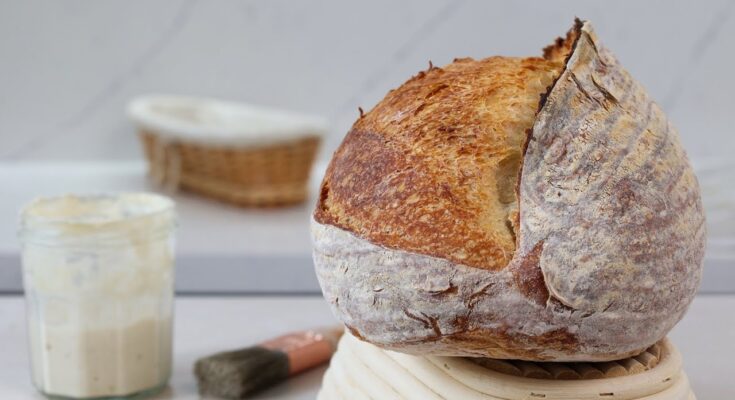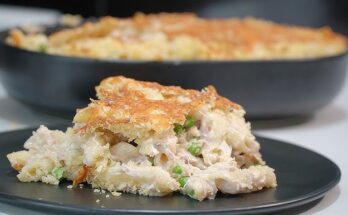Sour Dough Bread Recipe: Sourdough bread is a traditional, naturally leavened bread made using wild yeast and lactic acid bacteria. Unlike commercial bread, which uses store-bought yeast, sourdough gets its rise from a fermented starter. This starter is a mix of flour and water that captures wild yeast from the environment, creating a bubbly, tangy, living culture. The result? A loaf that’s complex in flavor, easy on the stomach, and downright delicious.
But what really makes sourdough stand out is its fermentation process. That slow, natural rise doesn’t just enhance the flavor—it improves the texture, digestibility, and even the nutritional profile of the bread. It’s like bread with a built-in superpower.
Why Choose Sourdough Over Commercial Bread?
Let’s face it—most store-bought bread is bland, overly processed, and packed with preservatives. Sourdough, on the other hand, is bread in its purest form. Here are a few reasons to switch:
- Better for your gut: The long fermentation process helps break down gluten and phytic acid, making sourdough easier to digest.
- Rich in flavor: That tangy taste? It comes from the natural acids and bacteria formed during fermentation.
- Fewer ingredients: All you need is flour, water, and salt. That’s it.
- Longer shelf life: Sourdough stays fresh longer due to its natural acidity.
- Customizable: Once you get the hang of it, you can tweak hydration levels, flour types, and baking styles to suit your taste.
In short, sourdough isn’t just bread—it’s a lifestyle. And once you go sour, you never go back.
Essential Ingredients for Sourdough Bread
The Role of Each Ingredient
Believe it or not, a classic sourdough loaf only requires three ingredients:
- Flour – Provides structure and flavor. High-protein flours like bread flour or whole wheat work best for strong gluten development.
- Water – Hydrates the flour, activates the gluten, and supports fermentation.
- Salt – Enhances flavor and regulates yeast activity.
Of course, the real MVP is the sourdough starter. It’s a mix of flour and water teeming with wild yeast and bacteria. This is what gives sourdough its signature rise and sour tang.
Optional additions include seeds, herbs, olives, or nuts if you’re feeling fancy. But keep it simple to start—you can always experiment later.
Best Types of Flour for Sourdough
Your choice of flour can make or break your sourdough experience. Here’s a quick breakdown:
- Bread Flour: High protein content (12-14%) = better gluten structure = strong, chewy crumb.
- All-Purpose Flour: Works fine, but may result in a slightly softer, less structured loaf.
- Whole Wheat Flour: Packed with nutrients and flavor, but heavier. Best when mixed with bread flour.
- Rye Flour: Great for starters due to its ferment-friendly sugars, but too much can lead to dense loaves.
For beginners, start with a 50/50 mix of bread flour and whole wheat. It gives you the best of both worlds: strength and flavor.
Tools You’ll Need
Must-Have Equipment for Sourdough Baking
While sourdough baking doesn’t require a ton of gear, a few key tools can really up your game:
- Digital Kitchen Scale: Accuracy matters in baking—eyeballing just won’t cut it.
- Mixing Bowls: Preferably glass or stainless steel for easy monitoring and cleaning.
- Bench Scraper: Super handy for handling sticky dough and shaping loaves.
- Dutch Oven: Mimics a steam oven, creating that crusty, bakery-style exterior.
- Lame or Sharp Razor Blade: Used to score the dough so it expands while baking.
Optional Tools That Make It Easier
- Banneton Basket: Helps the dough hold its shape during the final proof.
- Thermometer: For checking dough or water temperature.
- Silicone Dough Mat: Keeps your workspace clean and dough manageable.
You don’t need a fancy setup, but investing in a few quality tools will make the process smoother and more enjoyable. Think of them as your sourdough sidekicks.
Step-by-Step Sourdough Bread Recipe
Step 1: Preparing Your Sourdough Starter
If you don’t already have a starter, you’ll need to create one—and yes, it takes about 7 days. But once it’s alive, it’s yours for life with a little maintenance. Here’s how to start:
- Mix 50g of flour (whole wheat or rye is best) with 50g of water.
- Let it sit in a loosely covered jar at room temp.
- Feed it every 24 hours with the same amounts.
- By Day 4 or 5, you’ll notice bubbles and a tangy aroma.
- By Day 7, it should double in size within 4-6 hours of feeding—ready to use!
Once it’s active, you can store it in the fridge and feed it weekly.
Step 2: Mixing the Dough
Now that your starter is alive and kicking, it’s time to make the dough. Here’s a basic recipe to get started:
Ingredients:
- 500g bread flour (or a mix of bread and whole wheat)
- 375g water (about 75% hydration)
- 100g active sourdough starter
- 10g sea salt
Instructions:
- In a large mixing bowl, combine the flour and water. Mix until no dry bits remain. This is called autolyse—it allows the flour to absorb water and kickstarts gluten development. Let it rest for 30-60 minutes.
- Add the sourdough starter and salt. Mix thoroughly using the stretch-and-fold technique or by hand kneading in the bowl.
- The dough will be sticky—don’t worry! You want it to be well-mixed but not overworked. Cover the bowl with a damp towel or plastic wrap.
This is your dough’s foundation. You’ll be amazed at how it transforms over the next several hours. Just be patient—it’s alive, and good things take time.
Step 3: Bulk Fermentation
This is where the magic happens. During bulk fermentation, the dough ferments and rises slowly over several hours. Here’s what to do:
- Let the dough sit at room temperature for about 4–6 hours. Ideal temp: 75°F to 80°F (24°C to 27°C).
- Perform a stretch and fold every 30 minutes for the first 2 hours. Gently pull up one side of the dough and fold it over. Rotate the bowl and repeat on all sides.
- As you continue, the dough will become smoother, more elastic, and hold its shape better.
You’ll know the dough is ready when it has risen by about 50%, feels airy and jiggly, and shows bubbles on the surface. If it’s over-proofed, it might spread too much and become hard to shape—so keep an eye on it!
This phase builds strength, structure, and flavor. It’s like a workout for your dough—and trust me, it pays off in the oven.
Step 4: Shaping the Dough
Shaping is crucial because it determines how your loaf will look and rise. Here’s how to do it:
- Gently turn your dough onto a lightly floured surface.
- Pre-shape the dough into a round ball using your bench scraper. Let it rest for 20 minutes—this relaxes the gluten.
- After resting, do the final shaping:
- For a round boule: Pull the dough edges into the center, then flip and tighten into a ball.
- For a batard (oval): Fold the top third down, the bottom third up, then roll it into an oval.
Place the shaped dough into a floured banneton basket or a bowl lined with a floured kitchen towel.
Don’t worry if it looks rustic or uneven—each loaf has its personality. The key is building tension in the dough surface so it holds its shape.
Step 5: Final Proofing
Now, the dough needs a final rest. This proofing stage develops more flavor and helps the dough hold its form before baking.
You’ve got two options:
- Room Temperature Proof (2-4 hours): Keep it covered and let it rise until it passes the “poke test” (gently press the dough; if it springs back slowly, it’s ready).
- Cold Proof (12-18 hours in the fridge): This method is preferred by most bakers. The cold slows fermentation, enhances flavor, and makes the dough easier to handle.
Cold proofing also allows you to bake at your convenience—plus, it gives that crisp crust and open crumb we all love. Just pop the basket in a plastic bag or cover it with a shower cap and chill overnight.
Step 6: Scoring and Baking
Time to bake that beauty! Preheat your oven and Dutch oven to 500°F (260°C) for at least 30-45 minutes before baking. This ensures maximum oven spring.
- Flip the dough out onto parchment paper.
- Use a lame or sharp razor to score the top. A single slash down the middle or decorative cuts—your call. Scoring controls how the dough expands in the oven.
- Carefully place it into the hot Dutch oven, cover, and bake for 20 minutes.
- Remove the lid and bake for another 20–25 minutes until the crust is deep golden brown.
Let it cool on a wire rack for at least an hour before slicing. I know, it’s hard to wait—but slicing too early can ruin the crumb and texture.
Congratulations! You’ve just baked real-deal sourdough from scratch.
Tips for Perfecting Your Sourdough Bread
Common Mistakes to Avoid
Even experienced bakers run into sourdough hiccups. But knowing what to watch out for can save you a lot of frustration. Here are some common sourdough mistakes and how to avoid them:
- Using an inactive starter – Your starter needs to be bubbly and double in size within 4–6 hours after feeding. If not, it won’t have the power to raise your dough.
- Too much flour during shaping – Flour is your friend during shaping, but too much can prevent proper dough tension and lead to a dense loaf.
- Under or over-proofing – Proofing too little = tight, gummy crumb. Too long = flat, deflated bread. Use the poke test to gauge readiness.
- Not scoring deep enough – Scoring helps control how your loaf expands. If you skip it or score too shallow, you might get random bursts and an uneven shape.
- Cutting the bread too early – Sourdough continues to set after baking. Cutting too soon can ruin the texture. Let it cool for at least an hour.
Sourdough is part science, part intuition. Pay attention to temperature, timing, and texture—and don’t stress over imperfections. Every loaf is a lesson.
Understanding Fermentation and Temperature
Fermentation is the soul of sourdough. It’s what gives the bread its rise, flavor, and texture. But here’s the thing: fermentation is highly temperature-dependent.
- Cooler temps (65–70°F) = slower fermentation = more complex flavors but longer process.
- Warmer temps (75–80°F) = faster fermentation = quicker loaves, but higher risk of over-proofing.
Your kitchen environment plays a big role. If it’s cold, you can use a proofing box, warm oven with light on, or place the dough near a warm appliance. If it’s hot, consider shortening bulk fermentation or proofing in the fridge sooner.
Also, keep in mind that your starter is sensitive to temperature. If your starter is sluggish, it may just need a warmer spot to thrive.
Here’s a helpful table:
| Temperature | Fermentation Speed | Flavor Profile |
|---|---|---|
| 65°F (18°C) | Very slow | Very tangy, complex |
| 75°F (24°C) | Ideal | Balanced flavor |
| 85°F (29°C) | Fast | Milder, slightly sweet |
Remember, you’re not just baking—you’re cultivating a living ecosystem. Treat your dough with patience and care, and it’ll reward you tenfold.
Storing and Enjoying Your Sourdough
Best Ways to Store Sourdough Bread
You’ve baked a masterpiece—now how do you keep it fresh? Sourdough doesn’t contain preservatives, but it still has an impressive shelf life due to its natural acidity.
Here are the best ways to store it:
- Room Temperature: Wrap in a clean kitchen towel or store in a paper bag for up to 3 days. Avoid plastic—it traps moisture and makes the crust soggy.
- Bread Box: A bread box maintains the right balance of airflow and humidity. Perfect for keeping the crust crisp and the inside soft.
- Freezing: Want to keep your loaf longer? Slice it and freeze the pieces in a ziplock bag. Just toast or reheat when ready to eat.
Avoid refrigerating bread—it dries it out faster than room temperature or the freezer. If your sourdough starts getting a bit stale, don’t toss it! Keep reading…
Creative Ways to Enjoy Sourdough
Sourdough is a blank canvas for culinary creativity. Beyond simple butter and jam, here are some mouth-watering ways to enjoy your homemade loaf:
- Avocado Toast – Top with smashed avocado, poached eggs, and chili flakes.
- Grilled Cheese – The tangy crust pairs perfectly with melted sharp cheddar.
- Sourdough Croutons – Cube, toss in olive oil and herbs, then bake till golden.
- French Toast – Dip slices in egg-milk mixture and cook until golden. Add cinnamon and maple syrup.
- Sourdough Pizza Crust – Flatten leftover dough and bake with toppings for a delicious sourdough pizza.
Got leftovers? Turn stale slices into breadcrumbs, panzanella salad, or even a sourdough stuffing. Waste not, want not!
FAQs about Sour Dough Bread Recipe
1. What is sourdough bread?
Sourdough bread is a type of bread made from naturally occurring yeast and bacteria in flour. It is known for its characteristic tangy flavor, chewy texture, and crispy crust. Unlike commercial breads that use fast-acting yeast, sourdough fermentation takes longer, giving it its unique qualities.
2. Why does my sourdough bread not rise?
If your sourdough bread isn’t rising, it might be due to a few factors: the starter might not be active enough, the room temperature could be too low, or the dough might need more time to ferment. Ensure your starter is bubbly and active before using, and consider finding a warmer spot to encourage fermentation.
3. How do I make my sourdough bread crusty?
To achieve a crusty sourdough loaf, make sure to use a dutch oven or a steam-injected oven. The steam during the baking process creates a crisp outer shell. Preheat your dutch oven before placing your dough inside to bake; this mimics a professional baking environment.
4. Can I make sourdough bread without a starter?
No, sourdough bread requires a starter, which is a fermented mixture of flour and water that contains wild yeast and bacteria. If you don’t have a starter, you can easily make one from scratch with flour and water over a period of several days.
5. How long can I keep sourdough bread?
Sourdough bread typically lasts longer than commercially made bread because of its acidic nature, which helps prevent mold. It can usually be kept at room temperature for about 4 to 5 days. For longer storage, you can slice and freeze the bread for up to 3 months.
Conclusion
Sourdough bread is more than just a baking project—it’s a journey. From nurturing your starter to that final crusty slice, every step is a labor of love. And once you get the hang of it, it becomes almost meditative. The feel of the dough, the smell of fresh-baked bread, and the pride of cutting into your own homemade loaf—it’s pure joy.
Sure, there’s a learning curve. But the beauty of sourdough is in its imperfection. No two loaves are the same, and that’s part of the magic. So whether you’re baking your first boule or your fiftieth, trust the process, embrace the mess, and enjoy every crumb.



